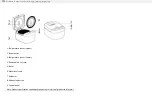
20
21
②
①
②
①
①
THE INTERIOR
HOW TO DETACH AND ATTACH THE INNER LID SET
Outer Lid / Steam Vent
Hold the Outer Lid securely and
wipe with a well-wrung soft cloth.
Remove any rice or residue on the
inside of the Outer Lid.
Heating Plate
Wipe the surface with a well-wrung soft
cloth.
If rice or other matter become stuck to the
Heating Plate, lightly polish them off with a
sandpaper of about No. 320 after dipping in
water.
If it becomes clogged with rice or other
matter, remove with a bamboo stick.
●
Leaving rice, other matter or
moisture on the surface may cause
the Outer Lid to rust or discolor.
Inner Lid Set
Inner Lid Gasket
Rinse in hot or cold water,
wash using a soft sponge, and
dry thoroughly.
●
Remove rice or other matter.
If not removed, steam may leak
through, rice may dry, or cooking
and Keep Warm may become
imperfect.
●
The Inner Lid Gasket cannot be
removed.
●
Be sure to clean the Inner Lid Set
after every use. If left dirty or wet,
the color may change to brown or
rust may form.
Center Sensor
Wipe with a well-wrung soft cloth.
If it becomes clogged with rice or other
matter, remove with a bamboo stick.
Inner Lid Set Holder
(orange)
Inner Lid Knob
Hold the Inner Lid
Knob (
①
), push up
the Inner Lid Set
Holder (
②
), pull the
Inner Lid Set forward,
and detach.
HOW TO DETACH
①
Line up the Inner Lid Set
Fixtures (2 positions) with
the Outer Lid Fixture
Holders, and then insert
the fixtures.
②
With the Fixtures inserted,
press on the Inner Lid Set
Holder until you hear a
click.
HOW TO ATTACH
Inner Lid Set Holder
(orange)
Fixtures
Fixture Holders
Enlarged illustration
Inner Lid
Gasket
CLEANING AND MAINTENANCE
(cont.)
●
Do not forcibly pull the Inner Lid
Knobs or Inner Lid Gasket toward
you without pressing the Inner Lid
Set Holder. May cause the Inner Lid
Set and Outer Lid to break.
TROUBLESHOOTING GUIDE
A noise is heard
during Cooking/
Keep Warm
The Reheat function
does not work
Problems
Possible Causes/Solutions
Rice cooks too
hard or too soft
Rice is scorched
Boils over while
cooking
Unable to start
cooking or the
buttons do not
respond
●
Increase or decrease water slightly (by 1-2 mm) from the Water Level Line according to your preference.
●
If the amount of water is adjusted with the Rice Cooker on a tilted surface, the amount of water
may be too high or too low, which will lead to changes in the hardness of the cooked rice.
●
The texture of rice varies depending on the brand of the rice, where it was harvested, and how
long it was stored (new crop or old crop).
●
The texture of rice varies depending on the room and water temperatures.
●
Using the Timer may result in softer rice.
●
Using the QUICK menu setting may result in harder or wet rice.
→
Please try using the WHITE menu setting.
●
Make sure the Inner Cooking Pan is not deformed.
●
Rice may not have been cleaned sufficiently, leaving too much bran on the rice.
●
Did you level the surface of the rice before cooking?
●
Did you loosen the rice after cooking was completed?
→
Loosen the rice immediately after cooking is completed.
●
Is there moisture or foreign matter such as (cooked or uncooked) rice on the bottom of the Inner
Cooking Pan, the Center Sensor, or the Heating Plate?
→
Wipe them off.
●
Is there moisture or foreign matter on the inside of the Main Body, the Inner Lid Set, or the Steam
Vent Cap?
→
Wipe them off.
●
Long Grain Rice may be slightly harder than normal.
→
To make it softer, fill the water slightly higher than the marked line on the Inner Cooking
Pan (to a point within half the distance to the next marked line) and cook. However,
please note that adding too much water may cause it to boil over.
●
Is there moisture or foreign matter such as (cooked or uncooked) rice on the bottom of the Inner
Cooking Pan, the Center Sensor, or the Heating Plate?
→
Wipe them off.
●
If you soak the rice for a long time or cook rice using the Timer, the bran may collect at the bottom,
and the rice will be more easily scorched.
●
Rice may not have been cleaned sufficiently, leaving too much bran on the rice.
●
Make sure the Inner Cooking Pan is not deformed.
The surface of the
cooked rice is
uneven
●
Depending on the heat convection while cooking, the surface of the cooked rice may look uneven.
●
Did you level the surface of the rice before cooking?
●
Make sure the Inner Lid Set and the Inner Cooking Pan are not deformed.
●
Did you use the wrong Menu setting or amount of water?
→
pg. 10
When cooking using the CONGEE THICK or CONGEE THIN menu setting, the contents are
particularly likely to boil over, so be sure not to use the wrong amount of water.
→
See “Be careful that the contents do not boil over.” on pg. 9
●
Make sure the Steam Vent Cap is attached.
●
Rice may not have been cleaned sufficiently, leaving too much bran on the rice.
●
Make sure the Inner Cooking Pan is not deformed.
●
Make sure the Power Plug is plugged in securely.
●
Is the Appliance Plug disconnected from the Plug Receptacle?
●
Does the Display show
“E01”
or
“E02”
?
→
pg. 24
●
Is the KEEP WARM light on?
→
Press the KEEP WARM/CANCEL button and press the START/REHEAT button.
●
Is “0” blinking on the Display?
→
Press the KEEP WARM/CANCEL button, and then perform other operations.
●
Did you press the START/REHEAT button after preparing to cook the rice?
→
The START/REHEAT button must be pressed to start cooking the rice.
Steam comes out
from the gap
between the Outer
Lid and the Main
Body
●
Make sure that the Inner Lid Set has not been dropped or deformed, and that the Inner Lid Gasket
is not torn.
●
Has the Inner Lid Gasket become soiled?
→
Clean the Inner Lid Gasket.
●
Make sure the Inner Cooking Pan is not deformed.
●
Make sure the KEEP WARM light is not off.
→
pg. 13
●
The microprocessor (MICOM) makes a sound while adjusting the heat power of the Rice Cooker.
This does not indicate a problem.
●
There is a spark-like noise when there is water left on the outside of the Inner Cooking Pan.
→
Always take precautions to wipe the outer surface of the Inner Cooking Pan and the
inside of the Main Body clean, especially of moisture and foreign matters, before placing
the Inner Cooking Pan into the Main Body.
COOKING
RICE
COOKING
RICE/
KEEP
WARM
Continued on the next page
●
Please check the following
points before calling for service.
































